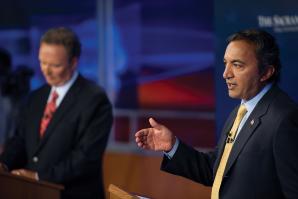This year, for the first time in a decade, California is likely to see seriously contested races for Congress. That is because the new Citizens Redistricting Commission dismantled the 2001 congressional gerrymander that kept almost all districts safe for incumbent parties. The Central Valley seems a likely battleground with four potentially hot congressional seats in Sacramento and its surrounding counties in play.
The hottest race will be in the new 7th Congressional district, in which incumbent Republican Dan Lungren will face his 2010 opponent, Democrat Ami Bera, a physician. Lungren narrowly won the 2010 race, despite it being a landslide year for the GOP. The new Commission district is a few points less Republican than Lungren’s old district, with party registration equal at 39 percent each. The Sacramento suburban district went for Democrat Jerry Brown for governor in 2010 by five points but supported Republican Carly Fiorina for U.S. Senate by seven points. The respected Rothenberg Political Report rates this as one of two “pure toss-up” districts in California.
But Lungren’s greatest problem may be the record of the Republican-controlled House of Representatives, whose approval rating hovers at about 11 percent. There is near universal agreement that the GOP House has failed to deliver on promises of job creation and major cuts in governmental spending. The Economist in its year-end summary of American politics put it well: “Even if this do-nothing 112th Congress manages to avoid mutilating the economy, it seems unlikely to do anything to help it. It looks clear that nothing of substance will be passed till after the presidential election on November 6th. This is both a disgrace and a tragedy; there are plenty of ideas that could boost employment. Schemes to back small businesses, set up an infrastructure bank or offer assistance for firms that hire the long-term unemployed are all marooned.”
Lungren’s fate, as with all Republican candidates in marginal districts, also rides on how well President Obama does in his re-election bid in California. If he runs anything like he did in 2008, when he carried the state with more than 61 percent of the vote, he could well swamp half a dozen GOP candidates. Right now, that seems unlikely, and he only carried the new 7th District by five points in 2008. Lungren’s survival probably depends on the Republican candidate running close to even against Obama in this district. There is no doubt that the congressional races will be “nationalized,” that is, people will vote for the same party for president and for Congress, as they have been doing frequently in recent elections.
The second close race in this area could be the 3rd Congressional District, where Democrat John Garamendi will seek re-election. While most Northern California Democrats landed good districts in the Commission’s maps, Garamendi was not so lucky. He went from an 18-point Democratic registration edge to a nine-point edge and picked up new, much less urban and less liberal territory, including Yuba and Sutter counties.
But before Republicans can mount a challenge to Garamendi, they
have to make sure the right Republican comes out of the primary.
That is Colusa County Supervisor Kim Vann, who has the support of
almost all the local elected Republicans. Whether this becomes a
serious race depends on how Vann does in the primary and whether
she can get into the November runoff against Garamendi.
South of Sacramento, San Joaquin County could see two contested
races. Rep. Jerry McNerney was the only Democrat to take a
Republican-held seat during the last decade, and he won a
district gerrymandered for the GOP. The Commission gave him a
district, the 9th Congressional, that is largely in San Joaquin
County, with the Antioch area in Contra Costa County. The
district has a nine-point Democratic registration edge, and
Democrats have carried it in almost all the overlapping races.
But McNerney will face an unusual candidate: 25-year-old law student Ricky Gill, who, like Bera in the 7th district, is Indian American. That has allowed Gill to raise a ton of money, and his campaign theme will be new blood. He will try to turn the 11 percent congressional approval rating to his advantage. Whether this is a winning formula may depend on how aggrieved a mood the voters are in this November.
The 10th District, just to the south, could see the same kind of a race. Republican Rep. Jeff Denham will seek re-election here. The district includes the southern part of San Joaquin County and all of Stanislaus County. Although it has a slight Democratic registration edge, Republicans have carried most of the overlapping races in recent years, and Obama received only 50 percent here in 2008.
But Democrats have come up with an unusual candidate in Stockton native and former astronaut Jose Hernandez. Like Gill in the 9th District, Hernandez calls himself a political moderate and will be campaigning on replacing the professional politicians with fresh faces.
In all four of these races incumbents will find themselves running against outsiders with limited experience in government, who will cite that as an advantage. Though the four races involve two Democratic and two Republican members of Congress, the challengers will try to tap into both Tea Party furry on the right and the Occupy intensity on the left. It could be a bumpy ride for all these incumbents regardless of their parties.
Recommended For You

GOP on Deck
Can the Republican contenders overcome Brown in 2014?
With just over a year until the midterm elections, California’s next gubernatorial race is starting to take shape.

Is Sacramento Permanently Democratic?
Voter trends with lasting effects
The 2012 election may have spelled the end for a 30-year boomlet of Republican legislative and congressional representation in Sacramento.


